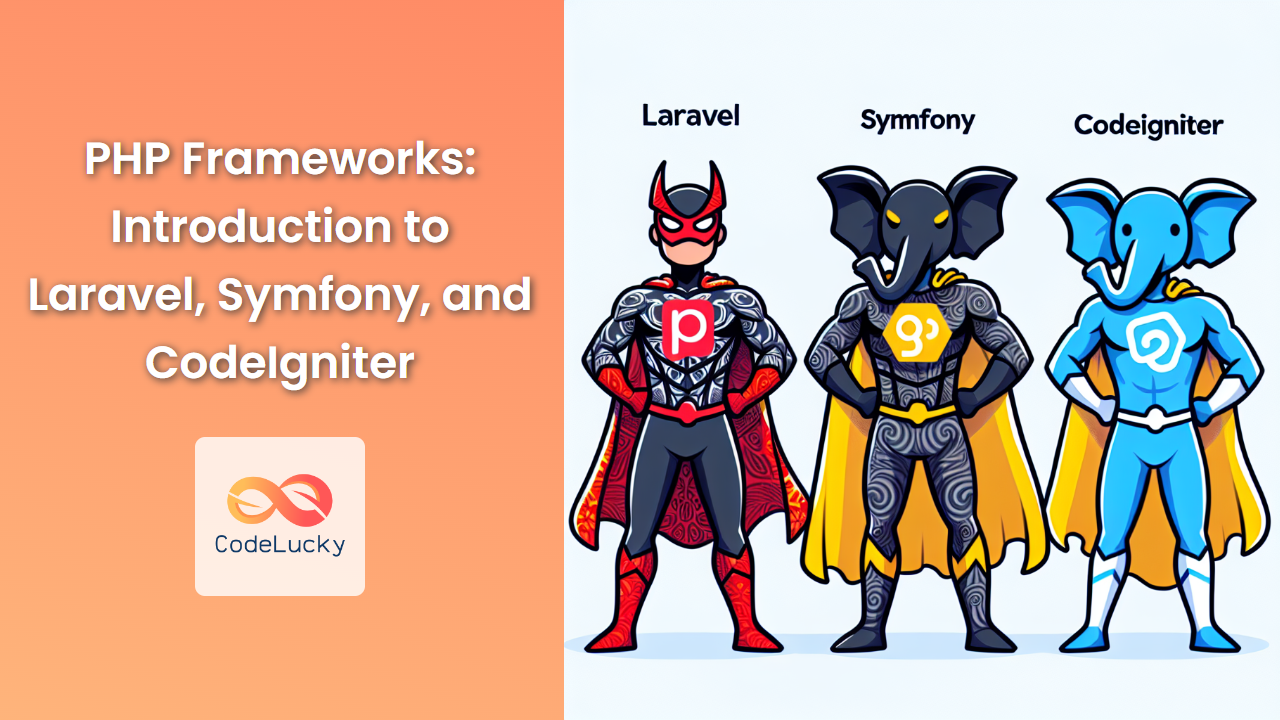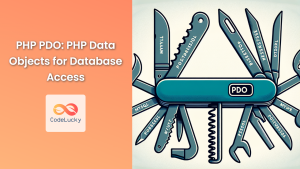In the world of PHP development, frameworks have become indispensable tools for building robust, scalable, and maintainable web applications. They provide a structured foundation, allowing developers to focus on creating unique features rather than reinventing the wheel for common functionalities. In this comprehensive guide, we’ll dive deep into three of the most popular PHP frameworks: Laravel, Symfony, and CodeIgniter. 🚀
Understanding PHP Frameworks
Before we explore specific frameworks, let’s understand what a PHP framework is and why it’s crucial in modern web development.
A PHP framework is a platform for developing PHP web applications. It provides a basic structure for building web apps, automating many of the common tasks performed in web development. This automation and structure help developers write cleaner, more organized code, and save time in the development process.
Key benefits of using PHP frameworks include:
- 🏗️ Improved structure and organization of code
- 🔒 Enhanced security features
- 🚄 Faster development time
- 🔧 Built-in tools and libraries
- 👥 Large community support
Now, let’s explore our three featured frameworks in detail.
Laravel: The PHP Framework for Web Artisans
Laravel, often referred to as “The PHP Framework for Web Artisans,” has gained immense popularity since its release in 2011. It’s known for its elegant syntax and robust features that make PHP development a joy.
Key Features of Laravel
- Eloquent ORM: Laravel’s built-in ORM (Object-Relational Mapping) makes database interactions a breeze.
- Artisan CLI: A powerful command-line tool for automating tasks.
- Blade Templating Engine: A lightweight yet powerful templating engine.
- Built-in Authentication and Authorization: Secure your application with ease.
- Testing Tools: Laravel comes with PHPUnit out of the box.
Laravel in Action
Let’s look at a simple example of how Laravel’s Eloquent ORM works:
<?php
namespace App\Models;
use Illuminate\Database\Eloquent\Model;
class User extends Model
{
protected $fillable = ['name', 'email'];
}
// In a controller or elsewhere:
$user = new User;
$user->name = 'John Doe';
$user->email = '[email protected]';
$user->save();
// Retrieving all users
$users = User::all();
// Finding a specific user
$user = User::find(1);
// Updating a user
$user = User::find(1);
$user->email = '[email protected]';
$user->save();
In this example, we define a User model that extends Laravel’s Model class. The $fillable property specifies which attributes can be mass-assigned. We then demonstrate creating, retrieving, and updating user records using Eloquent’s intuitive syntax.
Laravel’s Eloquent ORM abstracts away the complexity of database operations, allowing developers to work with database records as if they were simple PHP objects. This not only makes the code more readable but also significantly speeds up development time.
Symfony: The Professional PHP Framework
Symfony is known for its stability, flexibility, and enterprise-level capabilities. It’s often the choice for larger, more complex applications.
Key Features of Symfony
- Reusable Components: Symfony is built from decoupled and reusable components.
- Dependency Injection: Promotes loose coupling between classes.
- Event Dispatcher: Allows for flexible application architecture.
- Profiler and Debug Toolbar: Powerful tools for development and debugging.
- Twig Templating Engine: A flexible, fast, and secure template engine.
Symfony in Action
Let’s look at how Symfony handles routing and controller actions:
<?php
// src/Controller/ProductController.php
namespace App\Controller;
use Symfony\Component\HttpFoundation\Response;
use Symfony\Component\Routing\Annotation\Route;
class ProductController
{
/**
* @Route("/product/{id}", name="product_show")
*/
public function show($id)
{
// Retrieve the product from database (pseudo-code)
$product = $this->getDoctrine()
->getRepository(Product::class)
->find($id);
if (!$product) {
throw $this->createNotFoundException(
'No product found for id '.$id
);
}
return new Response('Check out this great product: '.$product->getName());
}
}
In this Symfony example, we define a controller action that responds to a route like /product/5. The @Route annotation specifies the URL pattern and gives the route a name.
The show method receives the $id parameter from the URL. It then uses Symfony’s Doctrine ORM to fetch a product from the database. If no product is found, it throws a “not found” exception. Otherwise, it returns a response with the product name.
This demonstrates Symfony’s approach to routing, which tightly couples routes to controller actions, making the application structure clear and easy to understand.
CodeIgniter: The Lightweight PHP Framework
CodeIgniter is known for its small footprint, simplicity, and excellent performance. It’s a great choice for smaller projects or when you need to get up and running quickly.
Key Features of CodeIgniter
- Small Footprint: CodeIgniter is lightweight and fast.
- Zero Configuration: Works out of the box with minimal setup.
- MVC Architecture: Follows the Model-View-Controller pattern.
- Built-in Security Tools: Includes XSS Filtering, CSRF protection, and more.
- Simple Database Classes: Makes database operations straightforward.
CodeIgniter in Action
Let’s look at how to create a simple controller and view in CodeIgniter:
<?php
// app/Controllers/News.php
namespace App\Controllers;
use CodeIgniter\Controller;
class News extends Controller
{
public function index()
{
$model = model('NewsModel');
$data = [
'news' => $model->getNews(),
'title' => 'News archive',
];
echo view('templates/header', $data);
echo view('news/overview', $data);
echo view('templates/footer', $data);
}
}
// app/Views/news/overview.php
<h2><?= esc($title) ?></h2>
<?php if (! empty($news) && is_array($news)): ?>
<?php foreach ($news as $news_item): ?>
<h3><?= esc($news_item['title']) ?></h3>
<div class="main">
<?= esc($news_item['body']) ?>
</div>
<p><a href="/news/<?= esc($news_item['slug'], 'url') ?>">View article</a></p>
<?php endforeach; ?>
<?php else: ?>
<h3>No News</h3>
<p>Unable to find any news for you.</p>
<?php endif ?>
In this CodeIgniter example, we create a News controller with an index method. This method loads a NewsModel (not shown here), fetches all news items, and passes them to the view.
The view file (overview.php) then iterates over the news items and displays them. CodeIgniter’s templating system is straightforward PHP, making it easy for PHP developers to pick up.
This example showcases CodeIgniter’s simplicity. With just a few lines of code, we’ve set up a controller that fetches data from a model and passes it to a view, following the MVC pattern.
Comparing the Frameworks
Now that we’ve explored each framework, let’s compare them:
| Feature | Laravel | Symfony | CodeIgniter |
|---|---|---|---|
| Learning Curve | Moderate | Steep | Easy |
| Performance | Good | Excellent | Excellent |
| Community Size | Very Large | Large | Medium |
| Best For | Rapid development, modern web apps | Large, complex applications | Small to medium projects, performance-critical apps |
| Database ORM | Eloquent | Doctrine | Simple query builder |
| Templating Engine | Blade | Twig | PHP |
| CLI Tool | Artisan | Console | Spark |
Choosing the Right Framework
Selecting the right framework depends on various factors:
-
🎯 Project Size and Complexity: For large, complex projects, Symfony might be the best choice. For medium-sized projects with rapid development needs, Laravel is excellent. For smaller projects or when performance is crucial, CodeIgniter could be ideal.
-
🧠 Learning Curve: If you’re new to frameworks, CodeIgniter might be the easiest to start with. Laravel has a moderate learning curve, while Symfony is the most complex but also the most flexible.
-
🛠️ Features Required: If you need a full-featured framework with many built-in tools, Laravel or Symfony would be good choices. If you prefer a minimalist approach, CodeIgniter might be more suitable.
-
🚀 Performance: While all three frameworks can be optimized for performance, CodeIgniter is known for its speed out of the box.
-
👥 Community and Ecosystem: Laravel has the largest community and ecosystem, followed by Symfony, then CodeIgniter. A larger community often means more resources, packages, and support.
Conclusion
PHP frameworks have revolutionized web development, offering structure, efficiency, and powerful features to developers. Laravel, Symfony, and CodeIgniter each have their strengths and are suited to different types of projects and developer preferences.
Remember, the best framework is the one that fits your project requirements and your team’s expertise. Don’t be afraid to experiment with different frameworks to find the one that works best for you. Happy coding! 💻🎉



















